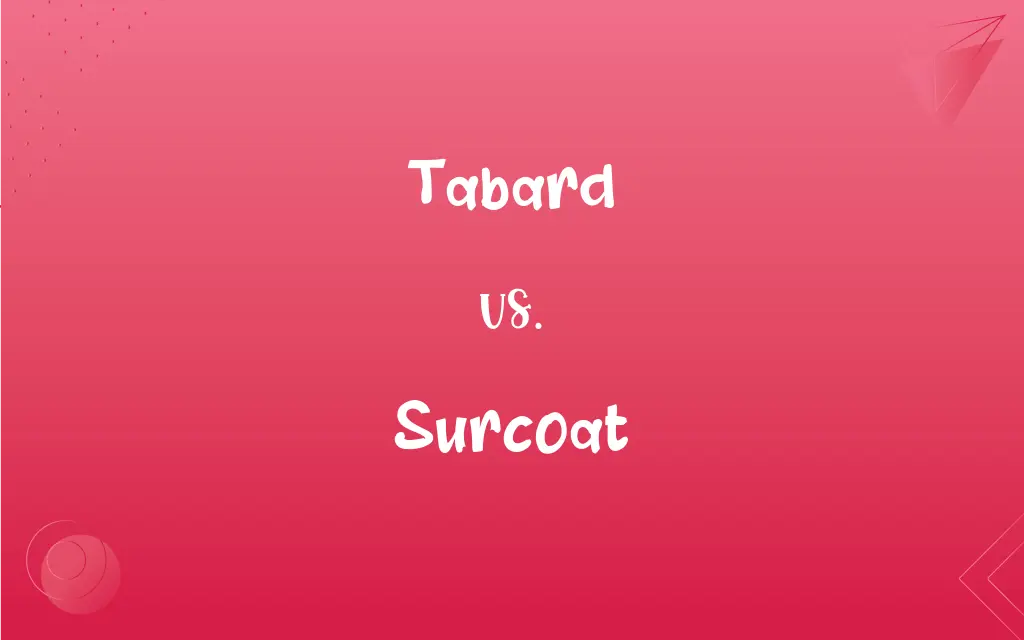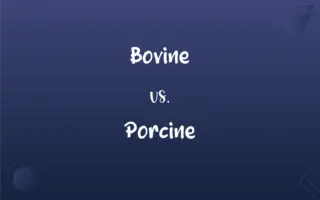Tabard vs. Surcoat: What's the Difference?
By Harlon Moss & Aimie Carlson || Updated on May 21, 2024
A tabard is a sleeveless outer garment worn by knights, often displaying heraldic symbols, while a surcoat is a long, loose garment worn over armor, also used to display heraldry but more covering.

Key Differences
A tabard is a sleeveless outer garment, usually featuring the wearer's coat of arms or heraldic symbols. It was primarily worn by knights over their armor, serving both as identification and protection from the elements. Whereas, a surcoat is a long, loose garment worn over armor that covers more of the body. It also often displayed heraldic symbols but provided additional coverage and protection.
Tabards were commonly used during the Middle Ages, particularly in the 13th and 14th centuries. They were simpler in design and provided easy movement for the wearer. On the other hand, surcoats emerged around the same time but evolved to offer more comprehensive coverage, extending down to the knees or ankles.
While tabards were often open at the sides and fastened with ties, surcoats were typically more enclosed, resembling a long tunic or coat. This design difference meant that surcoats offered better protection against the elements and could help to cushion blows in combat.
Tabards often had bold, simple designs that made it easy to identify the wearer from a distance. In contrast, surcoats, due to their larger surface area, allowed for more elaborate and detailed heraldic designs, which could convey more information about the wearer’s lineage and achievements.
Tabards were also used by heralds and messengers in royal courts, symbolizing their official capacity. Surcoats, while primarily functional, were also used ceremonially and could denote rank or status within a military or noble context.
ADVERTISEMENT
Comparison Chart
Design
Sleeveless, open-sided
Long, loose, more enclosed
Coverage
Upper body
Extends to knees or ankles
Usage
Identification, heralds, knights
Protection, identification, rank
Historical Period
13th-14th centuries
13th-14th centuries, evolved later
Heraldic Display
Bold, simple designs
More elaborate, detailed designs
ADVERTISEMENT
Tabard and Surcoat Definitions
Tabard
An official garment worn by heralds.
The herald wore a tabard emblazoned with the king's emblem.
Surcoat
A long, loose garment worn over armor by knights.
The knight's surcoat was embroidered with intricate designs.
Tabard
A sleeveless outer garment worn over armor by knights.
The knight's tabard displayed his family's coat of arms.
Surcoat
A garment symbolizing noble status or rank.
The prince wore a surcoat adorned with his crest.
Tabard
A simple, sleeveless tunic worn in medieval times.
Peasants sometimes wore plain tabards for work.
Surcoat
A loose, flowing coat-like garment in historical contexts.
Medieval soldiers often wore surcoats in battle.
Tabard
A vest-like garment in modern ceremonial contexts.
The reenactor's tabard was richly decorated.
Surcoat
A decorative, heraldic garment used in ceremonies.
The surcoat's detailed embroidery indicated his high status.
Tabard
A garment symbolizing office or duty.
The official donned a tabard to signify his role.
Surcoat
A loose outer coat or gown.
Tabard
A short, heavy cape of coarse cloth formerly worn outdoors.
Surcoat
A tunic worn in the Middle Ages by a knight over his armor.
Tabard
A tunic or capelike garment worn by a knight over his armor and emblazoned with his coat of arms.
Surcoat
(historical) A loose garment without sleeves worn over a suit of armor, sometimes colored or embroidered with the wearer's coat of arms.
Tabard
A similar garment worn by a herald and bearing his lord's coat of arms.
Surcoat
(historical) An overgarment worn over a woman's gown; a kind of short robe worn over the tunic at the close of the 11th century.
Tabard
An embroidered pennant attached to a trumpet.
Surcoat
A coat worn over the other garments; especially, the long and flowing garment of knights, worn over the armor, and frequently emblazoned with the arms of the wearer.
A long surcoat of pers upon he had..
At night, or in the rain,He dons a surcoat which he doffs at morn.
Tabard
A silk banner attached to a bugle or trumpet.
Surcoat
A name given to the outer garment of either sex at different epochs of the Middle Ages.
Tabard
A sleeveless jerkin or loose overgarment.
Surcoat
A loose outer coat usually of rich material
Tabard
(historical) A sleeveless garment made of coarse cloth formerly worn outdoors by the common people.
Surcoat
A tunic worn over a knight's armor
Tabard
(historical) A cape or tunic worn by a knight, emblazoned with the coat of arms of his king or queen on the front.
Surcoat
A protective outer layer for soldiers in the medieval period.
His surcoat protected him from the cold and rain.
Tabard
(historical) A similar garment officially worn by a herald and emblazoned with his sovereign's coat of arms.
Tabard
A sort of tunic or mantle formerly worn for protection from the weather. When worn over the armor it was commonly emblazoned with the arms of the wearer, and from this the name was given to the garment adopted for heralds.
In a tabard he [the Plowman] rode upon a mare.
Tabard
A short sleeveless outer tunic emblazoned with a coat of arms; worn by a knight over his armor or by a herald
FAQs
What is a tabard?
A sleeveless outer garment worn by knights, often displaying heraldic symbols.
What is a surcoat?
A long, loose garment worn over armor, also used to display heraldic symbols but more covering.
When were tabards commonly used?
During the 13th and 14th centuries, primarily by knights and heralds.
When were surcoats commonly used?
In the same period but evolved for more comprehensive use over time.
Who wore surcoats besides knights?
Soldiers, nobles, and royalty.
What was the purpose of the designs on tabards?
To display the wearer's coat of arms for identification.
What was the purpose of the designs on surcoats?
To display heraldic symbols and convey status or achievements.
How does a tabard differ from a surcoat?
A tabard is sleeveless and simpler, while a surcoat is long, loose, and offers more coverage.
Who wore tabards besides knights?
Heralds and royal messengers.
What materials were surcoats made of?
Similar materials as tabards, with some being more padded or reinforced.
How were surcoats fastened?
They were typically more enclosed, like a tunic.
Did surcoats have sleeves?
They were generally sleeveless but more enclosed than tabards.
Were surcoats worn in battle?
Yes, providing additional protection and identification.
Are tabards and surcoats used today?
Mostly in historical reenactments and ceremonies.
How were tabards fastened?
Often tied at the sides.
Were surcoats used for protection?
Yes, they offered additional protection against the elements and combat.
What materials were tabards made of?
Typically fabric, often linen or wool.
Did tabards have sleeves?
No, they were sleeveless.
Were tabards worn in battle?
Yes, by knights over their armor.
Were tabards used for protection?
Primarily for identification, with some element of weather protection.
About Author
Written by
Harlon MossHarlon is a seasoned quality moderator and accomplished content writer for Difference Wiki. An alumnus of the prestigious University of California, he earned his degree in Computer Science. Leveraging his academic background, Harlon brings a meticulous and informed perspective to his work, ensuring content accuracy and excellence.
Co-written by
Aimie CarlsonAimie Carlson, holding a master's degree in English literature, is a fervent English language enthusiast. She lends her writing talents to Difference Wiki, a prominent website that specializes in comparisons, offering readers insightful analyses that both captivate and inform.































































